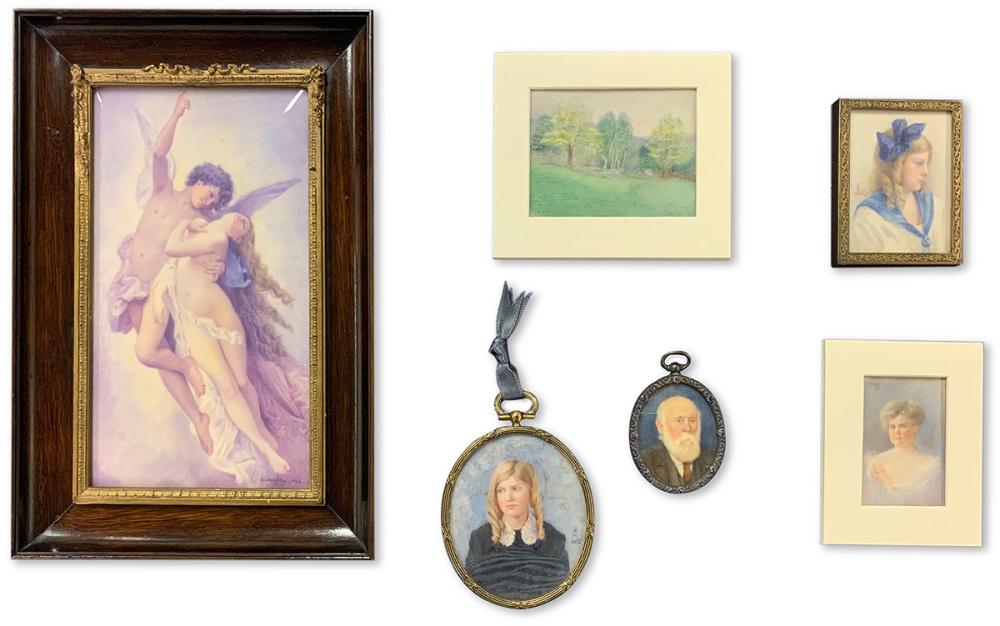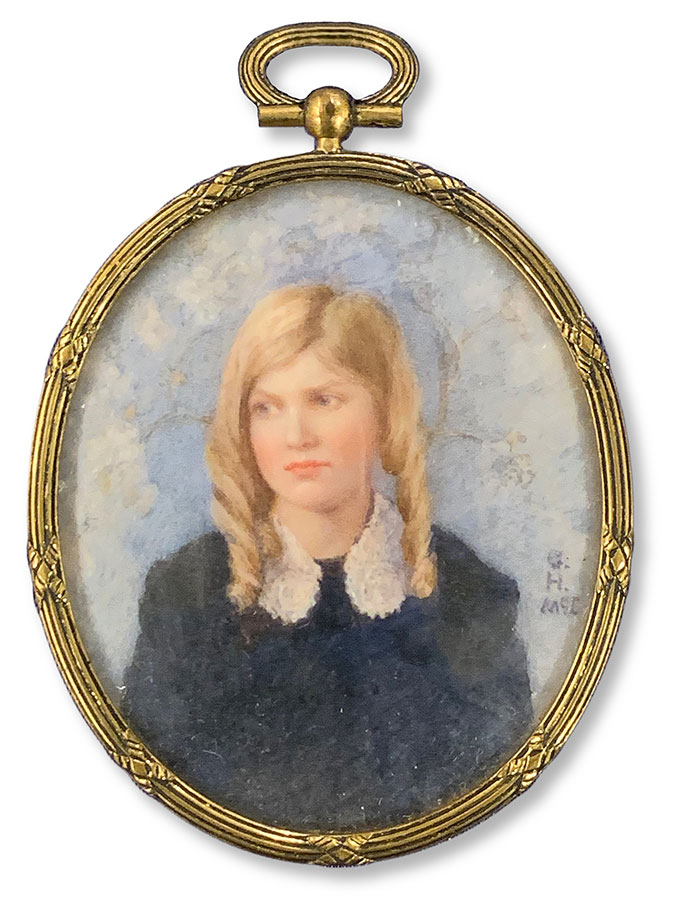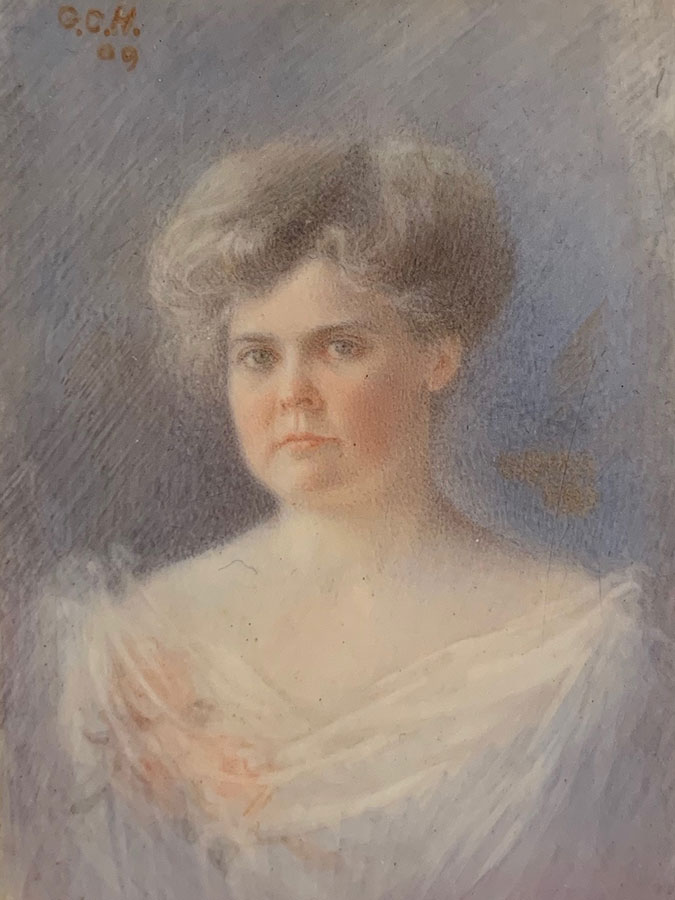Virtually no art object is without a complicated history concerning its creation and its journey from the artist to the museum. As repositories for art, museums no longer merely preserve the past—they must also actively work toward interpreting and uncovering tangled and often discomforting histories with a critical eye and open mind. During the prolonged period of working from home, and with the aid of snapshots taken by my colleague Maria Fredericks, Director of the Morgan’s Thaw Conservation Center, I embarked on a campaign to better understand and describe a group of miniatures on ivory that have been in the collection since 1991 but have not been thoroughly researched or interpreted. This cache of seven watercolors by the American artist Grace Hamilton McIntyre (1878–1962) are among the modest Morgan holdings of art by American women of the early twentieth century.

Fig. 1. Clockwise: Grace Hamilton McIntyre, Miniature of Cupid and Psyche, acc. no. AZ084; Miniature landscape on ivory, acc. no. AZ083; Square miniature of a young woman with blond hair, acc. no. AZ086; Miniature self portrait on ivory, acc. no. AZ082; Oval miniature of an old bearded man, acc. no. AZ087; Oval Miniature of a young woman with blond hair, acc. no. AZ085
The majority of the McIntyre miniatures in the collection are portraits (fig.1). These diminutive works, most of which barely surpass two inches, were intentionally scaled to be held in the hands of a single viewer in order to be properly seen, creating an intimacy born of proximity. Portraits of this kind serve as portable mementos of their sitters, who often cannot be close to the recipient for reasons ranging from an awaited marriage betrothal to separation by war. Crafted into small frames with the option to be worn, the bodily intimacy of these portraits can occasion powerful human emotion, and the objects speak strongly of how identity through portraiture is forged. At a time when standing closer than six feet apart is no longer safe, many turn to art as a surrogate for human connection and as a conduit for understanding ourselves.
A New York artist, Grace Hamilton McIntyre was born in Staten Island and attended Mademoiselle Veltin School for Girls on the Upper West Side, a school that was notable for its art department and counted the sculptor Malvina Hoffman (1885–1966) among its alumnae. McIntyre’s family briefly moved to Nebraska because of her father’s business in the sugar-beet industry but returned in 1892 so she could attend school. It was at this time she began showing an aptitude for china painting, which led her into the precise art of miniature painting. In the summer of 1899, McIntyre was invited to accompany her neighbors and family friends the Fabers (of the pencil-manufacturing company) on a tour of Europe. This travel undoubtedly provided McIntyre with invaluable exposure to art, inspiring her to launch into her career.
Much of McIntyre’s work consisted of commissions procured through family and friends, and she received as much as a thousand dollars for her portrait miniatures according to her daughter. A typical miniature done on commission may look like this portrait of a young woman (fig. 2) whose likeness is demurely rendered. This piece stands in contrast to McIntyre’s self-portrait of 1909, aged 31, where she appears self-assured with a frontal, outward stare (fig. 3). This is likely a wedding portrait given to Malcom McIntyre on the occasion of their marriage in 1910. She continued to work as an artist after getting married but essentially stopped after the birth of her daughter, Lois, in 1917.
The story of McIntyre is like that of many female artists, especially of her time. In many ways, she faced a system of misogynistic discrimination, perhaps being siloed to a medium deemed “suitable” for women and possibly feeling the pressure to give up her career after becoming a mother. In McIntyre’s biography, the artist’s daughter noted, “Society was not yet prepared to see a ‘lady’ help her husband make a living.” She was “patted on the head and allowed by her own rigid conscience to indulge in her sometimes lucrative hobby provided it did not interfere with…running her parent’s house.” And although she has to some extent fallen into obscurity, McIntyre’s work is represented in a number of major museums and is looked upon favorably by scholars of American miniaturists. She earned a place for herself through her dedication, persistence, and talent; just as importantly, though, she benefited from a broader framework of privilege afforded to her by her race and class.
The McIntyre family’s wealth came through her father’s sugar-beet business, part of an industry fraught with unethical practices. Sugar beets competed with cane grass, grown in tropical climates, as an alternative crop that could be cultivated in certain regions of America. Although this “home-grown” sugar did not have the same associations with the Atlantic slave trade, its production conditions were only barely better than those of slaves on sugar plantations. In the late 1880s, the state of Nebraska offered incentives to farmers to grow sugar beets, leading to the development of the Oxnard Beet Sugar Company in which McIntyre’s father James Hamilton was a primary investor. The company hired mostly German, Russian, and Mexican immigrant families to tend the fields. These jobs were poorly compensated. Entire families were often housed in shoddily constructed one- or two-bedroom homes, and children as young as five worked in the fields for up to thirteen hours a day. Lois McIntyre Darling noted that, “There were few amenities. Cheap Mexican labor worked amid the sugar beets. There were draughts, locusts, and fire.” Through no direct fault of her own, McIntyre’s success was, in part, built on the profits from unethical labor. The wealth McIntyre’s father gained from the sugar plantation afforded her the opportunity to go to school, to travel abroad, and to make valuable connections within her society to obtain high-priced portrait commissions.
White Americans saw in ivory’s creamy and semi-translucent surface a mirror on which to project their own likeness, especially the whiteness of their skin. Dating back to the eighteenth century, the belief that a person’s humanity was bound to and confirmed by the register of emotions visible through their complexion was embedded in the American psyche. Thomas Jefferson (1743–1826) espoused the superiority of white skin, which reflected “every passion by greater or less suffusions of color,” claiming that it was “preferable to that eternal monotony, which reigns in the countenances, that immovable veil of black which covers all the emotions of the other race.” This idea, paired with pseudoscientific claims of physiognomy, worked to create a reduction of skin color to race, and artists echoed the binary claim of “white” skin as the superior negation of Blackness. There is nothing inherently malicious about using a particular medium to represent pale complexions—artists were responding to a consumer base who could afford to commission work, who were predominantly white, and who wished to be represented in a manner that reflected wider social conventions at play in a market that was intrinsically linked to race. However, the materials and techniques of ivory miniatures contributed to the American construction of racial ideology.
Contemporary instruction manuals for miniature painting provide a revealing context in which artists learned their craft. Disproportionately targeted toward aspiring women artists, the manuals often espoused miniature painting’s gentility and accordance with womanly virtue and cited luminous flesh as the genre’s defining feature. McIntyre’s self-portrait provides an excellent example of the result of the painstaking process to create luminosity. Artists used the most translucent shades of watercolor the painter could achieve, applied in sheer layers to allow the ivory to shine through, as it appears in the statuesque bust of McIntyre’s self-portrait. Highlights in the face were executed by either leaving the ivory bare, or delicately removing painted layers to expose the support. Thus, the pale complexion was rendered in ivory, itself a material of luxury that implied a conflation of precious material with desirable appearance.
Ivory in museum collections has also become a contentious topic in recent years. The ivory trade has long endangered elephant populations and takes advantage of existing colonial-power imbalances inherent in the illegal trade of cultural objects and materials from non-Western countries. Any art made from ivory created outside of a country indigenous to the animal, such as portrait miniatures, are problematically linked to the exploitative ivory network. In 2016 the U.S. declared it illegal to import any ivory, historic or otherwise, into the country, implementing strict regulations that affect museum acquisition policies. The question arises: is it possible to exalt the craftsmanship of these pieces without implicitly supporting use of the problematic medium of ivory? This is just one of the challenges curators face as they delve deeper into their collections to elicit the narratives behind the creation of objects that have remained on the periphery.
Art objects, even as small and personal as the McIntyre ivories, hold a unique power to engage the senses, connecting body and mind and building meaning out of material. Art has the capacity to contribute both positively and negatively to the construction of identity through representation. Part of the responsibility of art institutions, as stewards of these objects, is to locate and bring to the surface these issues and to use objects as ambassadors of education towards a better understanding of our past and present systems of privilege.
Mary Creed
Zukerman Departmental Assistant
Department of Drawings and Prints
The Morgan Library & Museum
Images: Maria Fredericks


